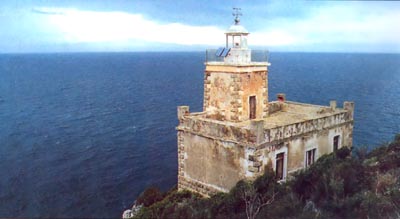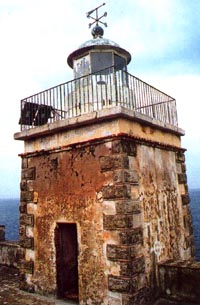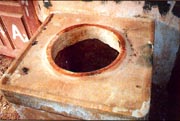
|
Original article and photographs by Christos Kotsonis
This land-and-sea monument is found south of Kalamata, a distance of 6 nautical miles, behind the bay of Kitries. We know that it was constructed in the year 1892 by the contractor Athanasios Marinos. The building of the lighthouse was erected on the spot where the greenery ends and the rocky cliff of the point begins, about 20 meters above the sea [roughly 60 feet]. It has the dimensions 7 x 11.5 meters [about 21 x 34.5 feet] and a total area of 80 square meters. It boats four ground-level rooms, which were utilized for the residence of the lighthouse keepers and are arranged in two's, on both sides of a chamber running along a central axis, in the middle of which there is an access from the single eastern outer door.
A kitchen is located in the northeastern room. Almost all the wooden doors and the windows have fallen apart, half rotten. The bathrooms were sheltered on the north in a separate outhouse that has since crumbled. Some special architectural characteristics stand out among the stone-hewn weighty walls: brown-colored, projecting cornerstones of equal size, just like the foundation stones, offer a contrast to the walls of the lighthouse, as well as to the white marble framing the doors and windows. The square tower, of the same construction as the central building, has a height of 11 meters. One of the most remarkable features of the lighthouse is an astonishing marble spiral staircase composed of wedge-shaped marble steps that form the center of a cylindrical column. The stairs lead to the top of the lighting machinery that has been abandoned today to bats whose droppings have covered the topmost steps. The square tower ends in a metal cage (housing for the light).
The History of the White Light The lighthouse has an assigned index number in the Greek Lighthouse [governmental] Code: A.E.F 2260-E-4032. It began operation on the first of June 1892 with the [law] number[ed] 27/1-5-1892 in the encyclical of announcements for the Maritime Ministry. It adopted the peristrophic system at that time, called "Sautter Lemonnier," with a clock mechanism for rotation with counterweights and petroleum as a source of energy. It transmitted a steady beam of one white burst of 30 seconds' duration and of sufficient luminosity for 10 nautical miles. In the year 1952 the light head "Chance" 800 m/m was installed, with a white light and range of 6 nautical miles. From 1999 on, collectors or "hive" lights, have been used that convert sun energy into electrical, stored within batteries; the body of the light works in two flashes of 12 seconds' duration and a range of 7 nautical miles. Since the time of the World War II, the lighthouse hasn't worked. A few days before the occupying German armies departed from Kalamata on August 6, 1944, they tried—in vain as it has been demonstrated—to bring the lighthouse down by setting up canons opposite it from the batteries of Kalamata. We should stress that the greatest damage to the Greek Lighthouse Network flared up during the time of the war and most certainly by the departure of German troops from Greece. In 1940 there were 206 stone lighthouses. After the end of the war only 19 remained working. The Lighthouse Keepers of Kitries The names and family villages of the lighthouse keepers who served at Kitries and are located in the archives of the Lighthouse Service are as follows: 1. Mihail Panagiotaros, from Oitylo 2. Elias Meleas, from Lefktro 3. Petros Dikeakos [Dikaiakos] or Koukouras, from Oitylo 4. Elias Smailis-Mihalopoulos, from Oitylo 5. Nikolas Garides, from Dolous 6. Andreas Gaitanaros, from Kitries 7. Nikolas Konstantakos, from the Demos Messis. 8. Antonios Fidopiastis [Pheidopiastes], from Oitylo 9. Dimitrios Petrogkonas, from Langkada [Lagkada] 10. Panagiotis Garides, from Kitries 11. Georgios Xarhakos, from Petalidi. 12. Theodoros Paraskevakos, from Methoni. 13. Ioannis Koumoutsakis, from Methoni 14. Pangiotis Koliakos, from Gytheio 15. Panagiotis Gkiouleas, from Prasteio 16. Panagiotis Georgaleas, from Selinitisa 17. Georgios Alafakis [Alaphakes], from Vatheia 18. Dimitrios Garides, from Dolous 19. Panagiotis Lagoudis, from Kitries 20. Georgios Garides, from Dolous 21. Vasileios Haralampeas [Charalambeas/Haralabeas], from Kardamyli 22. Grigorios Kamarineas, from Dolous 23. Ioannis Derkas, from Selinitsa 24. Mihail Lagoudakos, from Vatheia 25. Ioannis Kotsonouris, from Dolous 26. Dimitrios Margaritarakis, from Koroni 27. Lysander [Lisandros] Filippides [Philippides], from Exochori 28. Georgios Lagoudakos, from Kardamyli Christos Kotsonis is a journalist and editor-in-chief for the daily newspaper Simea of Messenia.He is the author of the original article in Greek and the accompanying photographs which appeared in the May-June 2003 issue of Mani magazine (pages 4-5). Permission granted by Mani representatives for HCS to reprint photos and to post article. Mary Papoutsy is a Classicist and former educator at the secondary and collegiate levels. Mrs. Papoutsy lectures on the Classics and Hellenic genealogy, having established the Hellenic Historical and Genealogical Association in 2000. She and her husband, Christos Papoutsy, created the Christos and Mary Papoutsy Endowed Chair in Business Ethics at Southern New Hampshire University. They also founded and are the publishers of Hellenic Communication Service. For more information about Mrs. Papoutsy, see the About Us section of the HCS Home Page at http://www.HellenicComServe.com/aboutus.html. (Posted July 2004) HCS Readers who have enjoyed this article may wish to browse others in our archives in the section titled "Travel in Greece" at http://www.helleniccomserve.com/archivetravelingreece.html. |
2000 © Hellenic Communication Service, L.L.C. All Rights Reserved.
http://www.HellenicComServe.com




